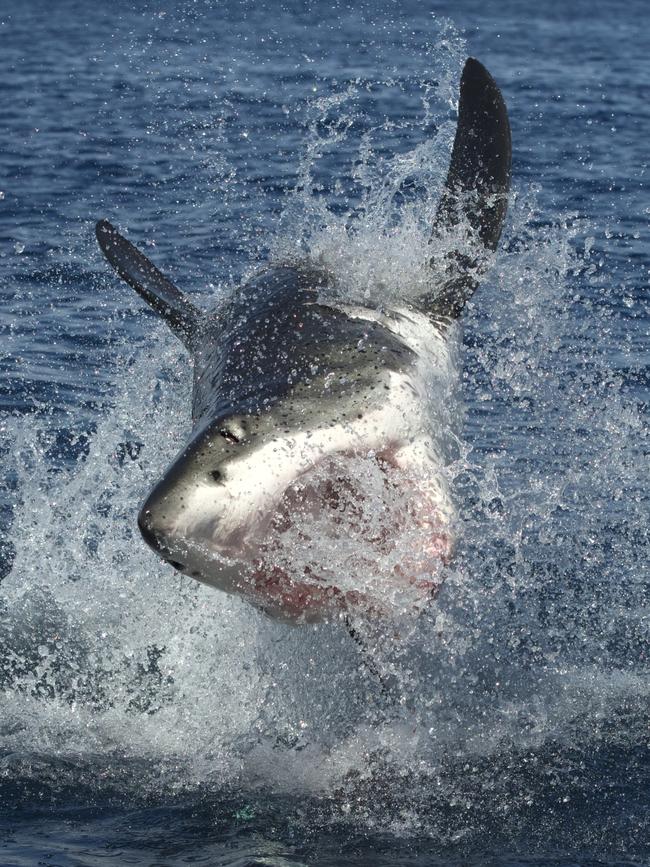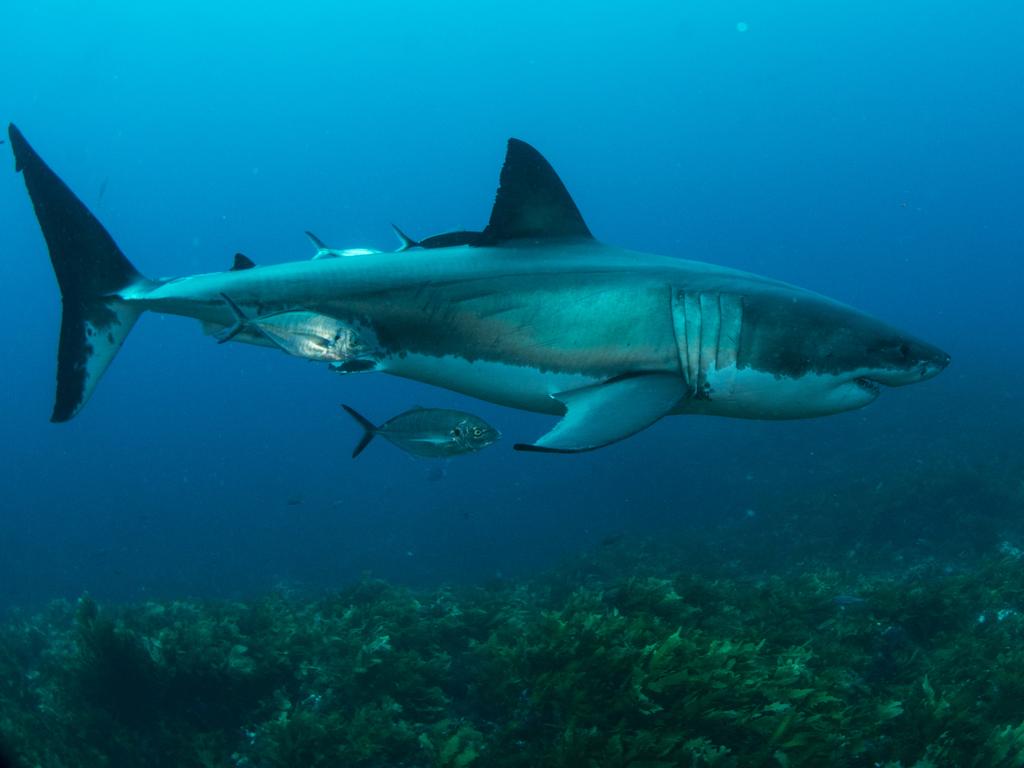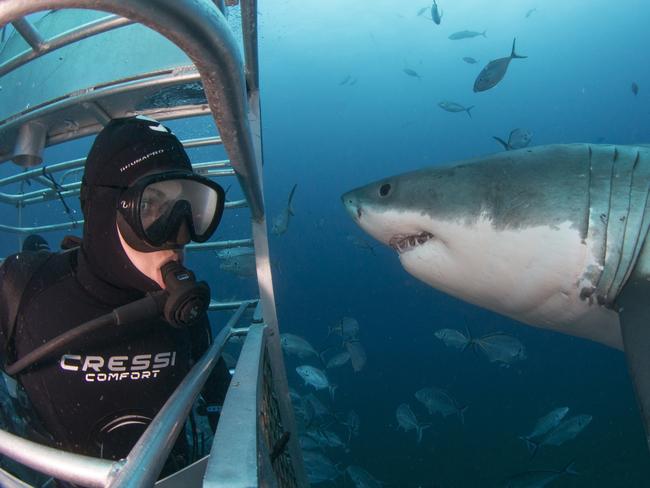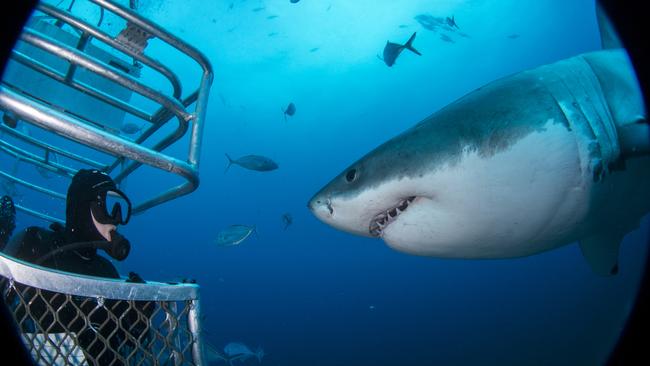The great white sharks of SA’s North Neptune Islands
Once maligned as monsters of the deep, great white sharks are now more often seen as fascinating apex predators — thanks in part to the efforts of Rodney Fox Shark Expeditions.
SA News
Don't miss out on the headlines from SA News. Followed categories will be added to My News.
As thick as a tree, Fat Vinnie glides past our cage with a barely-perceptible flick of his enormous tail.
He takes a peek inside, but it’s little more than a cursory glance — there’s nothing in here that he’s interested in. Instead Fat Vinnie’s mind is firmly fixated on the young long-nosed fur seals that are being kicked out of their North Neptune Islands home as their mothers prepare for new pups.

It’s these pups that will provide Fat Vinnie and his mates White Stripe and Pump Jack with this high-calorie snacks that will see them through the summer.
The cage is dangling off the back of Princess II, the 23m boat that serves as the base for Australia’s only live-aboard great white diving operation in Rodney Fox Expeditions. And while the names may seem like fun they’re actually a key part of the science that’s carried out on board the former fishing vessel. Each shark is identified by its unique combination of marks, scars and patterns that run along the animals’ countershading line. It’s a skill that has been honed to a fine art by expedition leader Andrew Fox, son of perhaps Australia’s most famous shark bite survivor Rodney.

Rodney was attacked by a great white while spearfishing off Aldinga in 1963. After almost dying from his wounds, the South Australian went on to devote his life to filming and studying the animals. Earlier this month he was presented with the Conservation Council Lifetime Achiever Award. Andrew has spent literally thousands of hours underwater with the apex predators over the past four decades and he can instantly recognise many of the white sharks that call the Neptunes home.
Every individual shark is logged by Andrew and the crew on-board the Princess II, with the logs proving a valuable tool for researchers over the years. Individual sharks are also tagged as part of a program in partnership with the state government and Flinders University. Shore based tracking equipment — accurate to within a metre — can then monitor the animals’ movements around the rocky islands.
Despite coming face-to-face Carcharodon carcharias more times that perhaps anyone else in Australia, the thrill never wears off for Andrew. “I was born into this,” he says.
“I remember as a child we’d take out groups of researchers and scientists from America and they were like astronauts to me. It was such an exciting life, and I’ve kept that going.”
Andrew says the trips had a multi-pronged mission — helping people overcome their fears, capturing unique imagery and providing a platform for shark science.
He says the Fox Expeditions model allowed tourism to fund the science.

“It’s been so great to be part of these voyages of discovery over the years,” Andrew says.
“And dad is so proud of his legacy of helping to introduce basically the entire world to the great white shark. He still gets a thrill from seeing the looks on people’s faces when they first come out of that cage. He’s played a big role in changing the image of great whites from basically a monster to something that’s seen more as a majestic predator with an important role to play.”
Andrew doesn’t shy away from the fact that cage diving is controversial among some industries and pastimes — abalone divers and surfers included — but he says much of the controversy can be traced to how the industry is promoted. “It’s always about the teeth and the menace and the fear factor, and I guess that’s understandable because people love adrenaline rushes,” he says.

“We like to turn that fear into fascination and education. That all links back to dad’s journey of overcoming his own fear and getting back into the ocean.”
The restrictions placed on the charter are tight — every kilo of chum is carefully weighed and logged, and if any of the tuna gills used as attractants are actually taken by a shark then the whole operation must be shut down for 15 minutes to avoid any feeding of the animals. There is even a camera on Hopkins Island to make sure the three charter operations obey the rules around interacting with Australian sea lions.
For award-winning underwater photographers Jayne Jenkins and Matthew Smith, on board as part of the Nikon Shark Shootout competition, the SA great white experience is one of the world’s best diving trips.
“You can’t dive with sharks anywhere else in the world like you can here,” Jenkins says. “Nobody else has the ocean bottom cage, and nobody else has Andrew’s passion and experience. This place is unique.”
It’s a sentiment that Smith agrees with.
“This is right up there,” he says. “There’s nowhere else in the world you can go to the sea bed in a cage and get that unique and serene perspective. The sharks down there are really relaxed and you can get wonderful portraits.
“To get so close to such a formidable animal is mind-blowing. This should be on everyone’s bucket list.”
For expedition information visit www.rodneyfox.com.au




